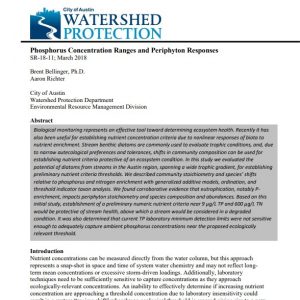Phosphorus Concentration Ranges and Periphyton Responses

Biological monitoring represents an effective tool toward determining ecosystem health. Recently it has also been useful for establishing nutrient concentration criteria due to nonlinear responses of biota to nutrient enrichment. Stream benthic diatoms are commonly used to evaluate trophic conditions, and, due to narrow autecological preferences and tolerances, shifts in community composition can be used for establishing nutrient criteria protective of an ecosystem condition. In this study we evaluated the potential of diatoms from streams in the Austin region, spanning a wide trophic gradient, for establishing preliminary nutrient criteria thresholds. We described community stoichiometry and species’ shifts relative to phosphorus and nitrogen enrichment with generalized additive models, ordination, and threshold indicator taxon analysis. We found corroborative evidence that eutrophication, notably P-enrichment, impacts periphyton stoichiometry and species composition and abundances. Based on this initial study, establishment of a preliminary numeric nutrient criteria near 9 µg/L TP and 600 µg/L TN would be protective of stream health, above which a stream would be considered in a degraded condition. It was also determined that current TP laboratory minimum detection limits were not sensitive enough to adequately capture ambient phosphorus concentrations near the proposed ecologically relevant threshold.